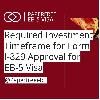EB-5 Visa Real Estate Investment | Paperfree's 2025 Insights
Discover the Benefits of EB-5 Real Estate Projects and How EB-5 Visa Real Estate Investment Can Secure U.S. Residency and Financial Growthlast updated Tuesday, September 9, 2025
#eb 5 visa real estate investment #eb5 real estate
| | by Sidra Jabeen | Content Manager, Paperfree Magazine |

QUICK LINKS
AD
Get Access to EB 5 Investment Visa Resources
Key Takeaway:
- EB5 real estate investment offers a path to U.S. residency via qualifying real estate projects.
- Minimum EB5 real estate investment is $800,000/$1,050,000 (TEA/non-TEA).
- Projects must create 10+ U.S. jobs for EB5 real estate investment qualification.
- EB5 real estate investment can be direct or through Regional Centers.
- Direct EB5 real estate investment offers more control, higher risk.
- Regional Center EB5 real estate investment is less control, lower risk.
- EB5 real estate investment projects include commercial and residential developments.
- Key risks in EB5 real estate investment: market changes, project delays, job creation.
- Due diligence is crucial for safe EB5 real estate investment.
- EB5 real estate investment provides potential returns and U.S. residency.
The EB-5 visa program is a U.S. immigration initiative designed to attract foreign investments that create jobs for American workers. One of the most popular avenues for fulfilling the program's requirements is through real estate investment. Under the EB-5 visa real estate investment option, foreign investors can contribute to large-scale real estate projects, such as hotels, residential developments, and commercial properties, to qualify for a U.S. Green Card. These projects not only serve as a viable investment opportunity but also play a key role in boosting the local economy by generating employment.
As the demand for EB-5 projects continues to grow, real estate has emerged as a secure and tangible option, with investors receiving both immigration benefits and potential returns on their capital. In 2024, the landscape of EB-5 program real estate investment is expected to evolve with new opportunities and challenges. Understanding how these investments work is essential for those looking to secure U.S. residency through this pathway.
Green Card Through Investment in Real Estate | What is EB-5 Real Estate?
Green card through investment in real estate or EB-5 real estate refers to real estate development projects funded by foreign investors under the EB-5 visa program. These projects are specifically structured to meet the requirements set by the U.S. Citizenship and Immigration Services (USCIS), which mandates that each investment must create at least 10 full-time jobs for U.S. workers. The investment can be made directly into a project or through an EB-5 regional center, which pools funds from multiple investors.
The primary appeal of EB5 real estate lies in its dual benefits. Investors can participate in tangible, large-scale developments—ranging from hotels and commercial spaces to multifamily residential buildings—while also meeting the immigration requirements to secure permanent residency. The value of these projects is not only in their potential for financial returns but also in their capacity to generate the necessary jobs to satisfy EB-5 program criteria.
Green card investment real estate, particularly in high-demand areas like New York, Los Angeles, and Miami, has consistently been a favorite choice for EB-5 investors. The stability of real estate, combined with job creation, makes it a reliable path for foreign nationals seeking a Green Card through the EB-5 visa real estate investment process.
The Role of Real Estate in EB-5 Investments
Real estate has become one of the most popular choices for foreign investors participating in the EB-5 visa real estate investment program. Its tangible nature, potential for returns, and ability to generate jobs make it a preferred asset class for fulfilling the visa's requirements. Investors can choose between a range of real estate projects that not only offer financial security but also help meet the employment criteria set by the U.S. Citizenship and Immigration Services (USCIS).
Why Real Estate is a Popular Choice for EB-5 Investors
The primary goal of the EB-5 visa program is to stimulate the U.S. economy through job creation. Real estate development projects are uniquely suited for this purpose because they often require large-scale construction efforts, which create numerous direct, indirect, and induced jobs.
- Direct Jobs
These are created by the businesses directly involved in the project, such as construction workers, engineers, and project managers. - Indirect Jobs
These jobs are generated through suppliers or services related to the project, such as the production of materials. - Induced Jobs
These arise from increased spending in the local economy by the workers employed on the project.
This broad range of job creation helps EB-5 real estate investments satisfy the requirement of generating at least 10 full-time positions per investor.
The Importance of Job Creation in EB-5 Financing for Real Estate
A core aspect of the EB-5 financing for real estate investments is ensuring that the project will result in the required number of jobs. Investors and developers must provide a detailed business plan that demonstrates how their project will create these jobs within a reasonable timeframe. Job creation is the critical metric upon which the success of the EB-5 visa real estate investment is measured.
The job creation factor, combined with the long-term value of real estate assets, makes this sector particularly attractive for EB-5 investors. Real estate investments provide a visible, tangible assurance that their contribution is being used for large-scale, impactful development.
Types of EB-5 Real Estate Projects
The EB5 real estate program supports a wide range of property types, giving investors the flexibility to choose projects that align with their financial goals and immigration needs. Below are some of the most common types of EB-5 real estate projects that are eligible under the program:
Commercial Properties
Commercial real estate projects are among the most popular choices for EB-5 investors. These include:
- Hotels
Construction and development of hotels are a consistent choice due to their high job creation potential. Projects like the Marriott Residence Inn have been successful EB-5 ventures. - Restaurants
Larger chain restaurants or restaurant complexes in urban areas are also common, as they create both direct jobs and continuous economic activity. - Retail Centers
Shopping malls or retail outlets are another option, as they generate long-term employment across various sectors.
Industrial Properties
Industrial properties, which include manufacturing and distribution facilities, are vital to the U.S. economy and can provide significant job creation.
Examples include:
- Manufacturing Plants
These facilities require extensive labor for production, operations, and supply chain management. - Distribution Centers
As e-commerce continues to grow, the demand for logistics and distribution hubs has surged, making them a strong candidate for EB-5 financing.
Residential Developments
Another common avenue for EB 5 financing for real estate is residential development. These projects cater to the rising demand for housing, especially in metropolitan areas, and can include:
- Condominiums
Multi-unit residential buildings that provide homes in urban centers. - Multi-family Housing
Large housing complexes or apartment buildings that offer housing for a wide range of tenants. - Senior Living Facilities
With an aging population, these developments are increasingly important and generate numerous jobs in care, management, and support roles.
Each of these EB-5 real estate projects provides a unique investment opportunity, allowing foreign investors to choose based on their risk tolerance, geographic preference, and financial goals. From commercial to residential developments, real estate remains a strong and stable sector within the EB-5 program, combining financial returns with the potential for U.S. residency.
EB-5 Real Estate Financing
EB-5 real estate financing refers to the structured process by which foreign investors contribute capital to real estate development projects in exchange for the opportunity to obtain a U.S. Green Card. The EB5 real estate investment process requires a minimum investment, often ranging from $800,000 to $1,050,000, depending on the project's location and its classification as a Targeted Employment Area (TEA).
How EB-5 Investors Contribute to Real Estate Development
EB-5 investors typically fund large-scale real estate projects, such as commercial or residential developments, through either direct investment or participation in an EB-5 Regional Center. In most cases, the funds provided by EB-5 investors are structured as equity or debt financing, which helps developers complete projects that might otherwise struggle to secure traditional loans. This financing model benefits both parties: investors gain a pathway to U.S. residency, while developers secure necessary capital to move their projects forward.
The primary requirement for EB-5 financing for real estate is that the project must create a minimum of 10 full-time jobs for U.S. workers, either directly or indirectly. As a result, real estate projects, which often involve extensive construction and ongoing operational jobs, are ideal candidates for the EB-5 program.
EB-5 Real Estate Financing
EB-5 real estate financing refers to the structured process by which foreign investors contribute capital to real estate development projects in exchange for the opportunity to obtain a U.S. Green Card. The EB5 real estate investment process requires a minimum investment, often ranging from $800,000 to $1,050,000, depending on the project's location and its classification as a Targeted Employment Area (TEA).
How EB-5 Investors Contribute to Real Estate Development
EB-5 investors typically fund large-scale real estate projects, such as commercial or residential developments, through either direct investment or participation in an EB-5 Regional Center. In most cases, the funds provided by EB-5 investors are structured as equity or debt financing, which helps developers complete projects that might otherwise struggle to secure traditional loans. This financing model benefits both parties: investors gain a pathway to U.S. residency, while developers secure necessary capital to move their projects forward.
The primary requirement for EB-5 financing for real estate is that the project must create a minimum of 10 full-time jobs for U.S. workers, either directly or indirectly. As a result, real estate projects, which often involve extensive construction and ongoing operational jobs, are ideal candidates for the EB-5 program.
Key Steps in EB-5 Real Estate Investment
Investing in an EB-5 visa real estate investment requires several critical steps to ensure compliance with USCIS regulations and maximize the chances of success for both financial returns and immigration outcomes.
1. Initial Search and Consultation
The first step involves finding suitable EB-5 real estate projects that align with the investor’s goals. This often includes consulting with immigration attorneys and financial advisors to assess both the project’s potential and the investor’s eligibility for the EB-5 program real estate investment.
2. Selecting a Real Estate Project
Once the search is complete, investors select a real estate project that meets the EB-5 program's requirements. Factors such as job creation potential, geographic location, and the reputation of the developers should be carefully evaluated.
3. Due Diligence
Due diligence is critical to verify the legitimacy of the chosen project. Investors must ensure that the project has a solid business plan, a clear job creation strategy, and is backed by reputable developers. Understanding the financial structure of the project is also essential during this phase.
4. Filing the I-526 Petition
The I-526 petition is the formal application submitted to the USCIS to demonstrate that the investment meets the EB-5 requirements. This includes providing proof of the investment, evidence of legal funding sources, and a detailed business plan showing how the project will generate the required jobs.
*Once the I-526 is approved, the investor and their immediate family can apply for a two-year conditional Green Card.
Risks and Benefits of EB-5 Real Estate Investment
Investing in EB5 real estate offers a unique opportunity for foreign investors to secure U.S. residency, but it also comes with its own set of risks and rewards. It's essential to understand both the benefits and potential challenges associated with EB-5 real estate investment to make informed decisions.
Benefits of EB-5 Real Estate Investment
- Tangible Assets
Real estate investments are physical, which provides investors with a sense of security and the ability to monitor their investment's progress. These projects can be easily evaluated and tracked over time. - Job Creation
One primary requirement of EB-5 real estate financing is job creation. Real estate projects often generate numerous direct and indirect jobs, which ensures compliance with the visa program's requirements. The construction and operation phases alone can often satisfy the job creation mandate. - Potential Returns
Depending on the real estate market and the specific project, EB-5 investors may see a return on their investment through rental income, property value appreciation, or both. This can provide not only a path to U.S. residency but also financial rewards over time. - Pathway to U.S. Residency
For many investors, the greatest benefit is the ability to secure U.S. permanent residency for themselves and their immediate family. The EB5 real estate investment acts as a direct means to obtain a Green Card, granting the investor long-term immigration benefits.
Risks of EB-5 Real Estate Investment
- Fraud and Misrepresentation
One of the biggest risks in EB-5 real estate financing is falling victim to fraudulent projects or developers. Due diligence is crucial to ensure the investment is legitimate, and investors should work with reputable regional centers and legal advisors. - Market Fluctuations
Real estate markets are subject to economic cycles, and downturns could negatively affect the project's success. This, in turn, could impact job creation and the overall return on investment. - Immigration Delays
The EB-5 visa process can be lengthy, with significant backlogs in processing times. Delays in USCIS processing can affect the investor's ability to obtain their Green Card, particularly if the job creation requirements aren't met within the expected timeframe. - Job Creation Uncertainty
While real estate projects generally create enough jobs, there is always the risk that the project may not generate the required number of jobs on time, potentially jeopardizing the investor's path to U.S. residency.
Regional Centers vs. Direct Investments in EB-5 Real Estate
When choosing an EB5 real estate investment, investors can opt for direct investments or investments through a regional center. Each approach has its own advantages and disadvantages, depending on the investor's goals, risk tolerance, and desired level of involvement.
Regional Center Investments
EB-5 Regional Centers are USCIS-approved organizations that pool EB-5 funds from multiple investors to support large-scale projects. These centers manage the project and oversee compliance with the EB-5 program’s job creation requirements.
Advantages
- Less Involvement
Investors do not need to manage the day-to-day operations of the project, as the regional center takes on this responsibility. - Easier Job Creation
Regional centers often use direct and indirect job creation models, making it easier to meet the 10-job requirement. - Diversification
Investors can spread their funds across multiple projects, reducing risk.
Disadvantages
- Less Control
Investors have minimal control over the project’s operations, which could be a concern if the project doesn’t perform as expected. - Dependent on the Regional Center
The success of the investment largely depends on the regional center's management and reputation.
Direct Investments
Direct investments require the investor to put their funds into a specific real estate project, often playing a more active role in the management and operations of the investment. This approach is more hands-on and requires a greater level of involvement from the investor.
Advantages
- More Control
Investors have direct involvement in the project's decision-making processes, giving them greater control over the outcome. - Clearer Job Creation
Direct investments can often clearly track job creation, as these are direct jobs created by the project itself. - Higher Returns
With more control comes the potential for higher financial returns, particularly if the project is successful.
Disadvantages
- Higher Risk
Direct investments carry more risk, as the project's success depends entirely on the investor's involvement and the project's performance. - Challenging Job Creation
Unlike regional centers, direct investments must generate 10 direct jobs, which can be more difficult depending on the project size and scope.
EB5 real estate projects: which Option is Better for Real Estate Investors?
The choice between regional center investments and direct investments depends on several factors:
- Risk Tolerance
Investors seeking lower risk and less involvement may prefer regional center investments. Those who are more comfortable with higher risk and desire more control over their investment may opt for direct investments. - Desired Involvement
Regional center investments are more passive, while direct investments require more hands-on management. - Job Creation
Regional centers generally provide a more streamlined job creation process, as they include both direct and indirect jobs, while direct investments require a more detailed plan to generate direct jobs.
Ultimately, both approaches have the potential to fulfill the requirements of the EB-5 visa real estate investment program. The best option will depend on the individual investor’s preferences, financial goals, and immigration timeline.
| Direct EB-5 Investment Management |
EB5 Regional Center Investment |
| Investment | |
| Invest directly in a specific U.S. business venture like a hotel, apartment complex, or manufacturing facility. | Pool your funds with other investors through a USCIS-approved regional center. |
| Job creation | |
| Directly create ten full-time jobs for U.S. workers through your project's activities. | The project can create jobs directly or indirectly through the economic activity it stimulates. |
| Management |
|
| You have more control over the project's management and operations, assuming greater responsibility. | The regional center handles oversight and management, reducing your workload and responsibility. |
| Risk | |
| Potentially higher risk due to your direct involvement in the project's success. | Generally, lower risk as your investment relies less on the success of a single project. |
Examples of EB-5 Real Estate Projects
Twin Lakes Georgia
Located in Hoschton, Georgia, Twin Lakes is a prominent project developed by the Kolter Group. This project has been named the 55+ Housing Community of the Year and has demonstrated substantial sales volume and job creation, which are crucial for EB-5 investments. The development includes a range of amenities and has already created significant numbers of EB-5-eligible jobs.
Copper Valley
Copper Valley, an EB-5 project, is strategically located to capitalize on the regional demand for its offerings. The project promises significant job creation and economic impact in its rural location, providing an excellent opportunity for EB-5 investors seeking priority processing and rural visa set-asides.
Kindred Resort at Keystone
Situated close to Keystone Ski Resort, this project offers luxurious condominium units with high demand shown through robust sales. Notable for its proximity to ski facilities, the project has successfully sold a significant percentage of its units well ahead of completion. It features a secured loan structure unique to rural EB-5 projects and has already fulfilled job creation requirements crucial for EB-5 investor eligibility.
All Points North
APN, located just outside Vail, Colorado, focuses on mental and behavioral health care. This direct eb-5 project has secured significant private equity funding, demonstrating strong financial stability and growth. Its rural TEA designation ensures priority processing and visa set-asides, making it a desirable option for investors interested in supporting a project with substantial community and humanitarian impact.
Conclusion
Investing in real estate through the EB-5 visa program offers a unique opportunity for foreign investors to secure U.S. residency and participate in high-value real estate projects with the potential for financial returns. With tangible assets, consistent job creation, and long-term immigration benefits, EB-5 real estate investments provide a reliable pathway to both economic and personal growth. From commercial and industrial properties to residential developments, investors can choose projects that align with their financial goals while fulfilling the job creation requirements necessary for U.S. permanent residency.
If you’re interested in exploring EB-5 real estate investment opportunities and direct EB-5 projects, contact PaperFree EB5 Visa Consultants. We offer expert guidance on available projects and comprehensive EB-5 consulting for property developers, helping you navigate the EB-5 program to ensure a secure and prosperous investment.
Book Your Free Consultation with Paperfree EB-5 Visa Experts. Get Personalized Advice and an Investment Plan. Book Your Free Consultation Today!

Frequently Asked Questions (FAQs)
What is EB-5 real estate investment, and how does it help in securing U.S. residency?
EB-5 real estate investment is a pathway for foreign investors to obtain U.S. residency by investing in real estate projects that create jobs. Investors must contribute at least $800,000 to $1,050,000 in a qualifying real estate project that generates at least 10 full-time jobs for U.S. workers. Upon meeting these requirements, investors can apply for a Green Card, allowing them and their immediate family to live and work in the U.S.
What types of real estate projects qualify for EB-5 investments?
The most common types of EB-5 real estate projects include commercial properties like hotels and restaurants, industrial properties such as manufacturing and distribution centers, and residential developments, including condominiums and multi-family housing complexes. To qualify for the EB-5 program, these projects must demonstrate significant job creation potential.
What are the main risks involved in EB-5 real estate investments?
While EB-5 real estate investments offer a tangible asset and potential returns, they come with several risks, such as market fluctuations, project delays, and the potential for not meeting job creation requirements. Additionally, fraudulent projects or untrustworthy developers pose significant risks, which is why thorough due diligence is essential before investing.
What is the difference between investing through an EB-5 regional center and a direct investment?
Investing through an EB-5 regional center involves pooling funds with other investors, offering less control but easier job creation through indirect means. Regional centers manage the projects on behalf of investors. Direct investment, on the other hand, requires investors to fund and manage a specific project themselves, offering more control but also higher risk and the responsibility to create direct jobs.
How long does it take to get a Green Card through EB-5 real estate investment?
The processing time for an EB-5 Green Card varies but typically ranges between 29.5 to 61 months for the I-526 petition to be approved. Once approved, investors and their families receive conditional Green Cards valid for two years. After fulfilling the job creation and investment requirements, they can apply to remove the conditions and obtain permanent residency.
How to use EB-5 capital in commercial real estate?
EB-5 capital can be used in commercial real estate by structuring projects that create at least 10 U.S. jobs per investor, meeting the program's requirements. Typical uses include financing developments like hotels, office spaces, and multifamily buildings. Typically, a new commercial enterprise (NCE) is set up to pool EB-5 funds, often via a regional center, and these funds are structured as either equity or debt in the real estate project. Projects in Targeted Employment Areas (TEAs) may qualify for a lower investment threshold, making them particularly attractive for EB-5 investors.
Why developers choose aim for EB-5?
Developers choose to aim for EB-5 because the EB-5 visa real estate investment model offers substantial benefits for large-scale projects. Green card through investment in real estate provides an attractive option for foreign investors, making EB-5 funding a reliable source of capital for property developers. By leveraging EB5 consulting for property developers, developers can secure necessary financing to complete projects with reduced interest rates compared to traditional loans. The EB 5 real estate investment strategy not only helps developers access capital but also supports the creation of U.S. jobs, fulfilling the program's requirements. This funding option has become popular among developers seeking to expand their projects while contributing to economic growth.
Pages Related to #eb 5 visa real estate investment
- Orlando multifamily market report

- EB5 Investment Projects | Here's All You Need To Know

- Paperfree Investment Visa EB-5 Program is Your Your Clear Path to Green Card USA

- July 2025 Visa Bulletin: EB-5 Investment Visa Program Shows Positive Movement

- EB-5 for Tech Entrepreneurs: Immigration Program for Startup Founders | Paperfree

- EB-5 Investment Protection: How Experienced Developers Safeguard Your Capital | Paperfree

- U.S.-Based EB-5 Investors Surge in 2025 | Concurrent Filing & Loan Repayment Explained

- Investment timeframe for Form I-829 approval for EB5 Visa

Popular Page
Benefits of the EB-5 Visa Program| A Comprehensive Guide
Book a Free Complimentary Call
real estate investing Investment Visa USA Investment Magazine Private Real Estate Funds real estate funds
